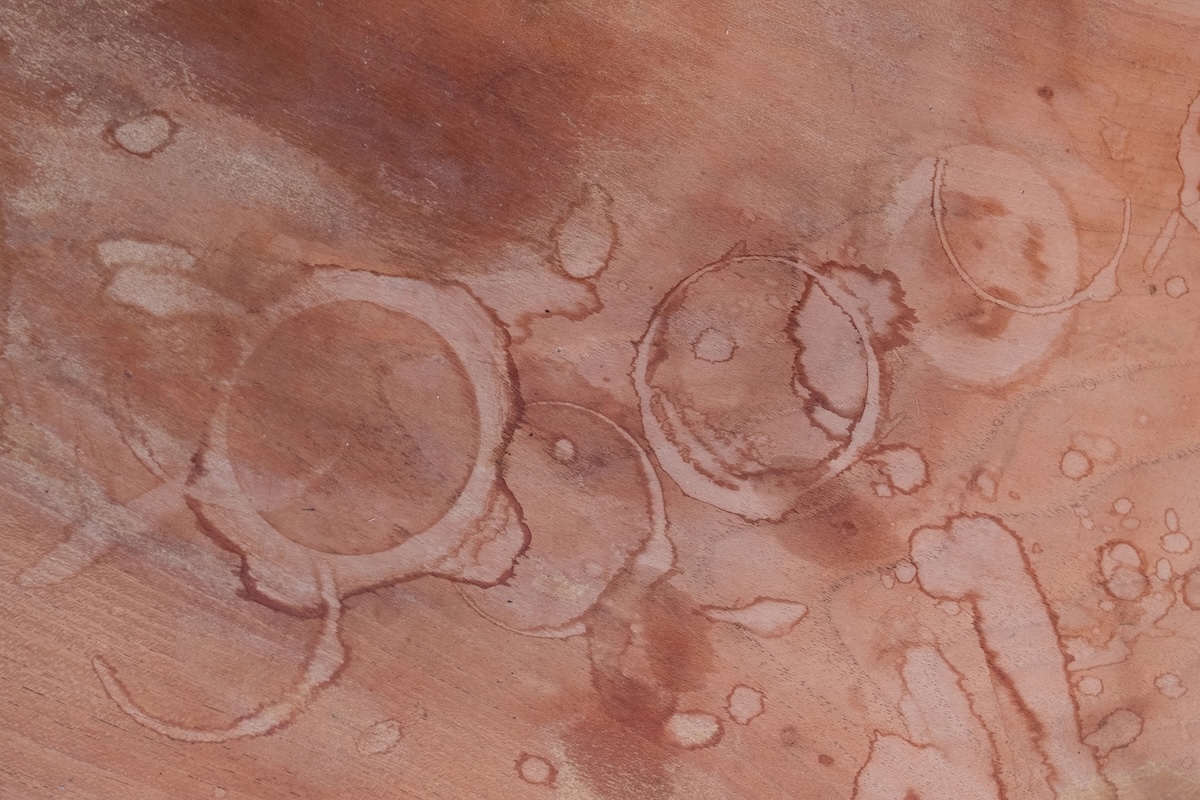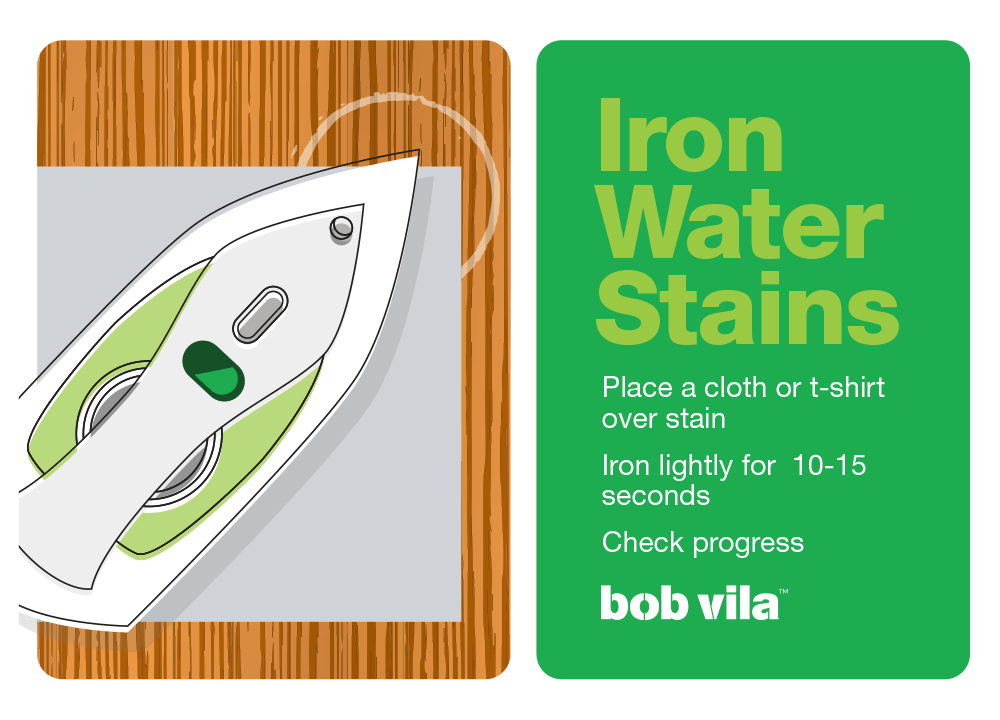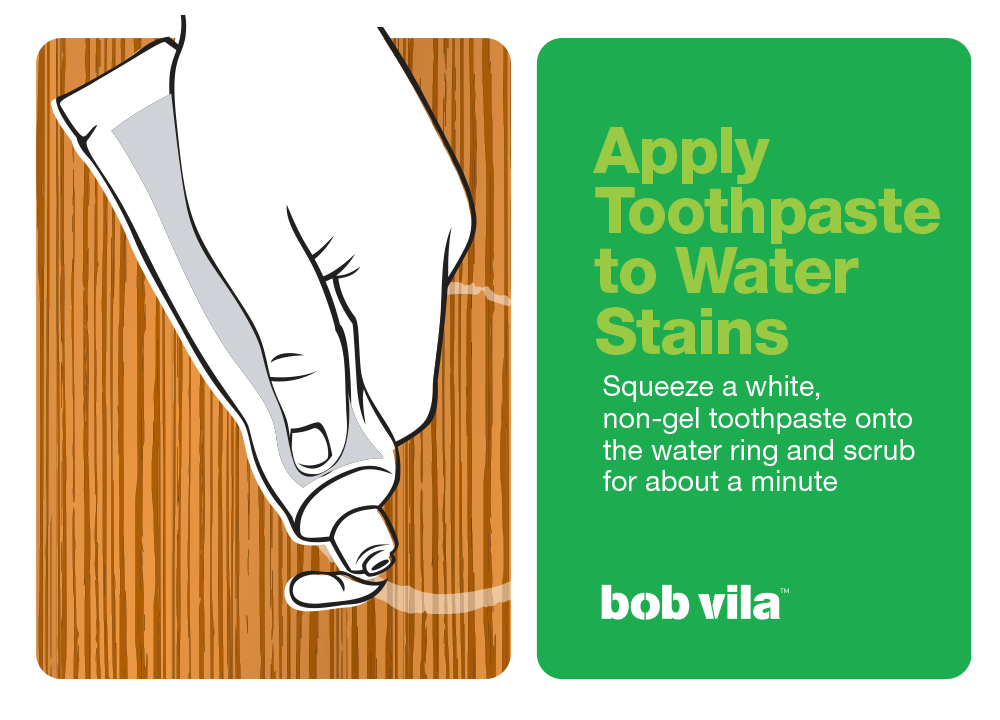

We may earn revenue from the products available on this page and participate in affiliate programs. Learn More ›
Wood furniture brings warmth and character to a space, but it’s not immune to accidents. Set down a cold drink without a coaster, and you may end up with a white ring or cloudy patch on the surface—a telltale sign of a water stain. These marks are common on everything from dining tables to coffee tables and can detract from the beauty of the piece.
The good news? When stains appear white or light-colored, it usually means the moisture is trapped in the finish rather than the wood itself. In many cases, that makes them easier to fix. If you’re wondering how to get water stains out of wood, try one of these six effective methods for restoring your furniture’s natural charm with minimal effort.
6 Methods for Removing Water Stains From Wood
The methods that follow use common household items and are relatively low-risk, especially for light-colored stains. There’s no strict order to follow, but it’s best to start with the least aggressive option and work your way up if needed. Try one method at a time and check your progress before moving on to the next.
Use a Clothes Iron

If the stain is recent (maybe a few days old), you may be able to lift it using a bit of heat. The idea is to gently draw out the moisture trapped in the finish without damaging the wood itself. A clothes iron on a low setting can do the trick, especially when paired with a layer of cotton fabric to protect the surface.
Make sure the iron is dry (no steam!) and start slowly. You’ll want to check your progress frequently to avoid overheating or making the stain worse.
SUPPLIES
- Clothes iron
- Cotton napkin or cloth
- Blow dryer (optional)
How to do it:
- Unplug and empty any water from your iron.
- Plug in the iron nearby and set it to the lowest heat setting.
- Place a clean, plain cotton cloth over the stain—avoid printed or decorated fabric.
- Press the warm iron onto the cloth for a few seconds at a time.
- Lift the cloth and check your progress. Repeat as needed until the stain fades.
Tip: No iron? A blow dryer on a low or medium setting can sometimes give you a similar result—just keep it moving over the stain for about 10 minutes.
Mix Vinegar and Baking Soda
For a more natural DIY approach, try a mixture of vinegar and baking soda, which can help lift water stains from wood. The mild acidity of vinegar breaks down residue, while the baking soda acts as a gentle abrasive to buff out the mark. This combo is great for persistent stains but should be used with care to avoid dulling the finish.
Test on a hidden area first, and don’t over-scrub—especially on delicate or antique wood.
SUPPLIES
How to do it:
- In a small bowl, mix equal parts white vinegar and baking soda to form a thick paste.
- Apply a small amount of the paste to the water stain using a cloth or sponge.
- Gently rub in a circular motion keeping pressure light.
- Let the paste sit for a few minutes, then wipe clean with a damp cloth.
- Dry the area thoroughly and buff with a soft cloth.
Try Olive Oil and Salt
If you’re dealing with a light water stain and want a gentle, natural fix, olive oil and salt might do the trick. The salt helps lift the moisture from the finish, while the olive oil restores a bit of shine and hydration to the wood. This method is safe, easy, and especially good for antique or delicate pieces.
SUPPLIES
How to do it:
- Mix a few drops of olive oil with about a teaspoon of salt to form a paste.
- Apply the mixture directly to the water stain.
- Gently rub with a soft cloth in a circular motion for a minute or two.
- Let it sit for another 10 to 15 minutes, then wipe off the residue with a clean cloth.
- Buff the area to restore the wood’s shine.
Dab Mayonnaise

As strange as it sounds, mayonnaise can actually help remove water stains from wood. The oil in it seeps into the finish and can displace trapped moisture, reducing the appearance of cloudy rings or spots.
This method takes a bit more time, but it’s gentle and worth a shot—especially on older or more delicate furniture.
SUPPLIES
- Mayonnaise (full fat works best)
- Cotton napkin or cloth
- Cotton rags
- Furniture polish
How to do it:
- Dab a small amount of mayonnaise onto a soft, clean cloth.
- Gently apply it to the water stain, coating the entire mark.
- Lay the cloth over the area and let it sit for a few hours (or overnight for tougher stains).
- Wipe away the mayo with a fresh cloth and check your results.
- Optional: Buff the area with furniture polish for a smooth finish.
Use Petroleum Jelly
Petroleum jelly is another low-risk overnight solution to help get rid of water rings on wood. Like mayonnaise, the oils in the jelly can penetrate the finish and help release trapped moisture. It’s an especially good option for older or valuable pieces you want to treat gently.
SUPPLIES
How to do it:
- Apply a generous layer of petroleum jelly directly to the stain.
- Let it sit for several hours, or ideally overnight, to allow the oils to work into the finish.
- Wipe away the jelly with a clean cloth and check your progress.
- If needed, repeat or follow up with a light polish to restore shine.
Apply Toothpaste

Toothpaste isn’t just for your teeth. It can also help lift water stains from wood. It needs to be classic white toothpaste, though. Gel formulas or those with added whitening agents can be too harsh. The mild abrasives in plain white toothpaste can gently polish out light moisture marks without harming the finish.
This method works best on smaller stains and should be tested on an inconspicuous area first to ensure it won’t damage the wood.
SUPPLIES
How to do it:
- Squeeze a small amount of white toothpaste onto a clean cloth.
- Gently rub the toothpaste into the stain using a circular motion. Start in a hidden spot to test it first.
- Keep rubbing lightly until the stain fades (this might take a minute or two).
- For tougher marks, use a soft-bristled brush to scrub gently for less than a minute.
- Wipe the area clean with a damp cloth and dry thoroughly.
What to Do if the Stains Won’t Budge
Even if the water stains on the wood surface aren’t completely gone, these methods may have at least lightened them enough to be less noticeable. If you’re not satisfied with the results, two additional options can help remove water rings from wood: You can try a commercial stain remover, like Guardsman’s Deep Clean, or you can refinish the wood.
Commercial stain removers are designed to eliminate watermarks as well as other stains on wood caused by markers, heat, and more. While some users have success with commercial stain removers, they aren’t 100 percent effective. These products can cause additional damage to your furniture’s finish, so you’ll always want to test them on a hidden area first.
The ace up your sleeve is that, if all else fails, you can always sand the furniture down to bare wood and refinish it with a new wood stain or even paint over the existing finish. (If you’re dealing with a prized piece, you may want to consult a pro.) When the project is done, keep coasters handy to prevent more damage in the future.
Tips for Keeping Wood Surfaces Clean
Once you’ve dealt with your water stains, the next step is to prevent them from happening again. To keep your wood furniture looking its best, a little routine care can go a long way to preserve the wood finish and prevent future damage.
Here are some simple tips for keeping wood surfaces clean and in great shape.
- Use coasters and placemats: Prevent moisture rings and heat stains by creating a barrier between your furniture and drinks, dishes, or hot items.
- Dust regularly: Use a microfiber cloth or soft duster to gently remove dust without scratching the finish.
- Avoid harsh cleaners: Stick to mild soap and water (sparingly), or use a wood-specific cleaner. Harsh chemicals can strip finishes and dull the surface.
- Polish occasionally: Apply a high-quality furniture polish or wax a few times a year to maintain shine and protect the finish.
- Clean up spills quickly: Moisture is the enemy. Wipe up water, wine, or coffee spills right away to avoid staining.
- Protect from sunlight: Prolonged exposure to direct sunlight can fade and dry out wood. Use curtains or rotate pieces to keep the color even.
- Use felt pads under decor: Lamps, vases, and other items can scratch wood over time. Stick felt pads to the bottoms to prevent damage.
- Control indoor humidity: Wood can expand or contract with moisture changes. Use a humidifier or dehumidifier to keep your home’s humidity stable.
With a little attention and care, your wood furniture can stay beautiful for years to come—and you’ll (hopefully) never have to deal with water rings again.
Final Thoughts
Water stains on wood tables can be challenging to remove. While the recommendations shared above do not guarantee success, they can be effective with some wood stains, or at least can help minimize the appearance of a stain.
If you do manage to effectively remove water stains from wood, take precautions to prevent new stains from forming. Seal and waterproof wood furniture with polyurethane or lacquer, use coasters and placemats, and follow best practices when cleaning your wood furniture (wood is one of those things that should never be cleaned with water).
FAQ
Mayonnaise can work well to remove an old white stain on wood. When you apply mayonnaise over the water stain and allow it to sit on the spot for a few hours, the oil in the mayonnaise will help remove the moisture and the cloudiness that accompanies it.
Yes, the methods shared above using a clothing iron, mayonnaise, or toothpaste can help eliminate or minimize water spots on wood furniture that has been finished.
Polyurethane and lacquer wood finishes can resist water stains. Polyurethane is a synthetic material that leaves a clear coat over wood. In addition to being water-resistant, polyurethane is durable and can help protect against damage. Lacquer leaves behind a glossier (or sometimes matte) finish. However, unlike polyurethane, lacquer should not be applied over old varnish or paint.
